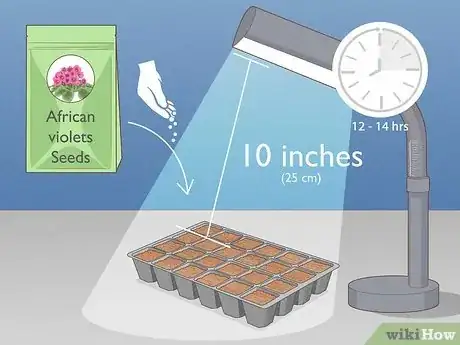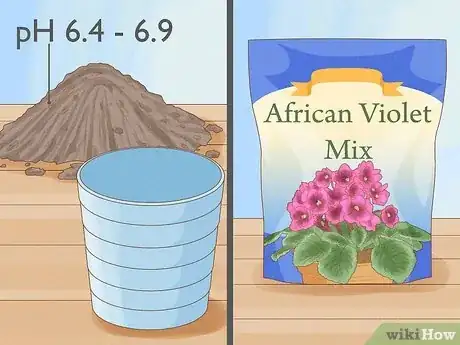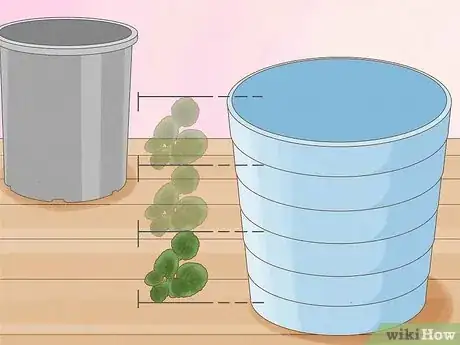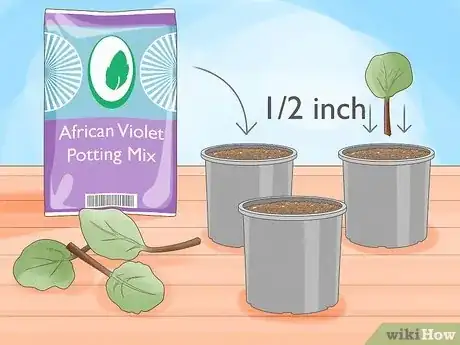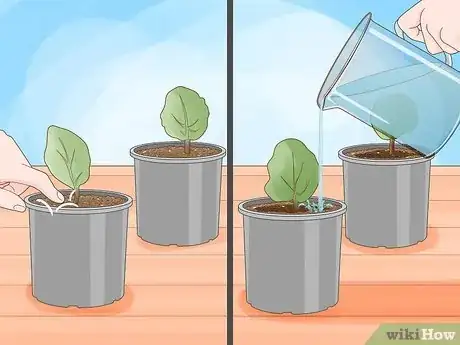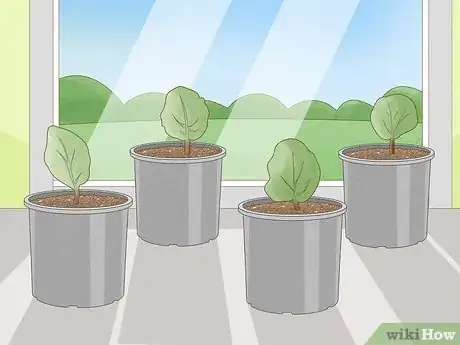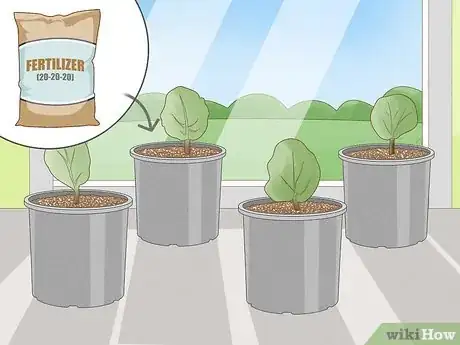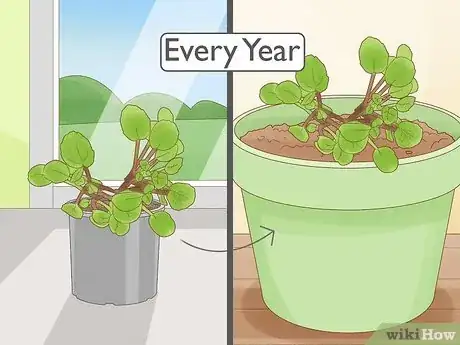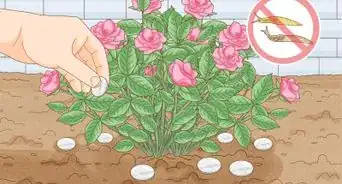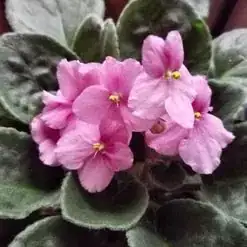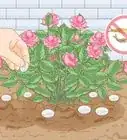This article was co-authored by Maggie Moran. Maggie Moran is a Professional Gardener in Pennsylvania.
wikiHow marks an article as reader-approved once it receives enough positive feedback. This article received 13 testimonials and 100% of readers who voted found it helpful, earning it our reader-approved status.
This article has been viewed 280,250 times.
African violets are a group of flowering perennial plants that are native to Tanzania, Kenya, and other areas of East Africa. Growing these violets at home is quite easy, but they need the right medium, nutrients, and environment to thrive. But as long as they get everything they require, African violets will bloom their beautiful purple flowers all year long, bringing a bit of summer to your home even in colder months.
Steps
Propagating African Violets
-
1Grow a new plant in water from a leaf. The most common way to grow new African violets is to propagate them from the leaves of existing plants. Once you do this, you can sprout the cutting in water. To propagate a new African violet in water, you'll need a sterilized cutting tool, a thin-necked bottle (such as a sterilized beer bottle), and a plastic bag or wrap.
- Select a large and healthy leaf from a healthy African violet.
- Include 2 inches (5 cm) of stem and cut the leaf from the plant on a 45-degree angle. The cut side of the angle should be on the top of the leaf.
- Fill the bottle with lukewarm water.
- Place the stem of the leaf into the neck of the bottle, so that the stem is in water and the leaf is resting above the rim.
- Cover the leaf and top of the bottle loosely with plastic to help keep in the humidity.
- Place the leaf somewhere warm that gets lots of filtered light.
- Add more water as necessary to keep the stem submerged.
- Over the next several weeks, the cutting will begin to sprout baby African violets.
-
2Plant a leaf right in the soil. Alternatively, you can also plant that same cutting directly into soil rather than sprouting it in water. To do this you'll need your healthy leaf and 2 inches (5 cm) of stem cut from a healthy violet, a small pot of clear plastic, potting soil, and a plastic cover or wrap.[1]
- Fill the pot with loose potting soil.
- Press the cut stem a half-inch (1.3 cm) into the soil.
- Cover the top of the pot with a clear plastic cover or wrap.
- Place the cutting somewhere warm where it will get lots of filtered sun.
- You probably won’t need to water as long as the plastic keeps in the moisture.
Advertisement -
3Grow them from seeds. One way to grow African violets is to start them from seed, though this is less common than propagating the plants from cuttings. To grow African violets from seeds, you'll need seed starters, a plastic cover or wrap, a spray bottle, growing lights, and a medium suitable for African violets, such as milled coconut and perlite or pasteurized peat moss.
- Water the medium and allow it to dry out so it’s moist.
- Fill the seed starters with medium.
- Spray the top of the medium with water.
- Sprinkle a few seeds into the top of each starter cell.
- Cover the top of the cells with plastic.
- Place the seed starters 10 inches (25 cm) below the grow lights.
- Provide the seeds with 12 to 14 hours of light per day.
- If the environment stays humid thanks to the plastic wrap, you won’t need to water.
Transplanting Young African Violets
-
1Determine the right time to transplant. Seedlings should reach a certain size before they're transplanted, but plants sprouted from cuttings will be ready to transplant after a certain amount of time.
- For seedlings, wait until the seedlings have leaves that reach 2 inches (5 cm) in width.
- For cuttings, the babies should be ready in about eight to 10 weeks, once new leaves are roughly the size of a dime.
-
2Choose the right soil. African violets grow best in a slightly acidic medium that has a pH between 6.4 and 6.9. Because the medium must be loose, well-draining, and allow for free root development, African violets are not often grown in soil.
- Most garden and home stores will sell a medium specifically designed for African violets.
- You can also make your own African violet mix by combining equal parts perlite, vermiculite, and peat moss.[2]
-
3Select the right pot. Because African violets are grown indoors, choosing the right pot is like choosing the right home for your plants. These plants grow best in pots that are sized for their root systems. Don’t put your plant in a pot that’s too large, otherwise it may not bloom.[3]
- A good rule of thumb is to put your violet in a pot that’s one-third the size of the plant itself, because this will match the size of the root system.
- For the current size of your seedlings or babies, a 2-inch (5-cm) pot will probably be sufficient.
- You can use either plastic or terracotta pots for your violets. Plastic pots require less watering, but terracotta pots provide more air flow.
-
4Separate plants grown from cuttings. When you propagate violets by cuttings, you could have as many as 15 babies grow from a single parent. These must be separated before they're planted. Gently turn the cutting, along with all the soil, out onto a newspaper or table. Carefully remove the soil with your fingers to reveal the cut stem and all the babies.
- To distinguish one baby from another, look for small clusters of leaves that are attached to the parent.
- When you’ve located all the babies, carefully trim each one from the parent using a sterilized cutting tool.
-
5Transplant the violets. Fill your small pots with your African violet medium. Leave the medium loose, and don’t pack it down. With the tip of your pinky finger or a pencil, make a half-inch (1.3 cm) indentation in the soil at the center of each pot.
- Gently place each seedling or baby plant into the hole in the soil. Make sure all the leaves and stems are above the soil.
- Loosely cover the roots with extra medium.
-
6Water the plants and store them somewhere warm and humid. Add some water to each pot so that the medium is moist. Place the pots with the new plants in a location that’s warm, gets lots of indirect sun, and that’s humid.
- If you don’t have a humid location available, set up a humidifier where the plants are growing.
Caring for African Violets
-
1Water the plants when the soil feels dry. African violets thrive best when their soil is somewhere between dry and moist, so give them water when the soil starts feeling dry to the touch. Over or underwatering the violets could prevent the plant from blooming.
- Use room temperature water rather than cold water, otherwise you could chill the roots. If this happens, the leaves or flowers may start to curl.
- Don’t get water on the leaves or flowers, as this can lead to rings or spots forming on the plant.[4] If you get water on the leaves or flowers, gently dry the area with an absorbent towel.
-
2Provide plenty of bright but indirect light. African violets need lots of light, and they won’t flower if they don’t get enough sun. However, they will scorch easily in direct sunlight, so their placement in the house is very important.
- In winter, the plants will do best near a window that faces south or west in the Northern Hemisphere, or north or east in the Southern Hemisphere.[5]
- In summer, the plants will be better near a window that faces north or east in the Northern Hemisphere, or south or west in the Southern Hemisphere.
- To provide bright and indirect sunlight, provide shade by placing the plants behind lightweight curtains.
-
3Feed them fertilizer. These plants need lots of nutrients to continue producing flowers year-round, and the best way to ensure they get what they need is to provide them with fertilizer.
- There are specific fertilizers available for African violets, but the important thing is to provide them with balanced nutrients.
- A good fertilizer would be a 20-20-20, which means it has equal quantities of nitrogen, phosphorous, and potassium.[6]
- Follow the manufacturer’s instructions for feeding the violets.
-
4Monitor the temperature. The best temperature range for African violets is between 65 and 75 F (18 and 24 C). Keep them in an area where you can maintain this temperature, and keep them away from drafts and other things that could cause sudden temperature fluctuations.[7]
- Anything below 50 F (10 C) will almost certainly kill the plant.
-
5Maintain the humidity. The ideal humidity level for African violets is between 40 and 60 percent. You can monitor this with a hygrometer. To add more humidity to the air, consider installing a portable humidifier in the room where the violets are kept.
- Violets that don’t get enough humidity will grow slowly, and while they will produce flower buds, they likely won’t bloom.[8]
-
6Repot the plants every year. Because African violets thrive in small pots, it’s important to repot them regularly to keep up with their growth. When you repot, make sure you use new soil, and a pot that’s one size larger than the pot they're currently in.
Expert Q&A
Did you know you can get expert answers for this article?
Unlock expert answers by supporting wikiHow
-
QuestionDo African violets need direct sunlight?
 Maggie MoranMaggie Moran is a Professional Gardener in Pennsylvania.
Maggie MoranMaggie Moran is a Professional Gardener in Pennsylvania.
Home & Garden Specialist
-
QuestionHow do you water an African violet?
 Maggie MoranMaggie Moran is a Professional Gardener in Pennsylvania.
Maggie MoranMaggie Moran is a Professional Gardener in Pennsylvania.
Home & Garden Specialist
-
QuestionHow long do flowers last on an African violet?
 Maggie MoranMaggie Moran is a Professional Gardener in Pennsylvania.
Maggie MoranMaggie Moran is a Professional Gardener in Pennsylvania.
Home & Garden Specialist How long the flowers last depend on a variety of factors. The varieties that have thick petals and flowers that are tinged with green tend to bloom longer. You can also make blooms last longer by keeping your plant in high humidity and cool temperatures. Removing dead petals can be beneficial as they can shorten the life of adjacent petals. With good, consistent light and proper care, most modern breeds of African violet will bloom almost indefinitely.
How long the flowers last depend on a variety of factors. The varieties that have thick petals and flowers that are tinged with green tend to bloom longer. You can also make blooms last longer by keeping your plant in high humidity and cool temperatures. Removing dead petals can be beneficial as they can shorten the life of adjacent petals. With good, consistent light and proper care, most modern breeds of African violet will bloom almost indefinitely.
References
- ↑ http://extension.uga.edu/publications/detail.cfm?number=C660
- ↑ http://www.weekendgardener.net/houseplant-care/african-violet-pot-031003.htm
- ↑ http://www.weekendgardener.net/houseplant-care/african-violet-pot-031003.htm
- ↑ http://www.optimara.com/africanvioletcare1.html
- ↑ http://extension.uga.edu/publications/detail.cfm?number=C660
- ↑ http://www.weekendgardener.net/houseplant-care/african-violet-pot-031003.htm
- ↑ http://www.weekendgardener.net/houseplant-care/african-violet-pot-031003.htm
- ↑ http://www.optimara.com/africanvioletcare1.html
About This Article
To grow African violets, start them from seed or plant a leaf from a mature African violet. When you plant your violets, use a well-draining soil that's slightly acidic and choose small pots. Then, put your plants in a warm, humid spot that gets lots of indirect sunlight. You'll need to water your violets whenever the soil they're planted in is dry, and it's also a good idea to feed them a balanced fertilizer so they continue to flower every year. Once a year, repot your African violets so their roots have more room to grow. To learn more from our Horticulturist co-author, like how to transplant your seedlings to another container, keep reading the article!


